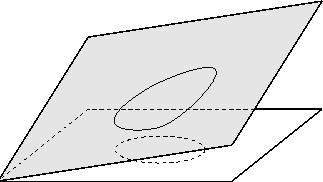
The key to this problem is that the words "expected change in a function for a unit change in a variable at variable=X" MEANS "take the derivative of the function with respect to the variable and evaluate at variable=X". It DOES NOT mean "evaluate the function at X-1 and X+1 and use those values to estimate the change at X".
The main idea is that if you restrict yourself to a parametrized curve, C, then the rate of change of a function restricted to C depends on how fast we move along C. Think about moving slowly along a roller-coaster track versus moving quickly over the same track: the faster you move, the "bigger" the drops and hills seem, even though the hills do not change their size.
A unit change in t makes a change of (l'(t), w'(t)) along the parametrized curve. This tangent vector determines the direction that we will use for the directional derivative. At t=3 Pi/2, the tangent vector to the circle is T=(2,0). Note that the norm of T is 2. But recall that the directional derivative (which we computed in question 1) is the change for a UNIT step in some direction. Since we are taking a step of length 2, the expected change is the area is TWICE the directional derivative in the direction (1,0).
Here's a summary of the answer:
